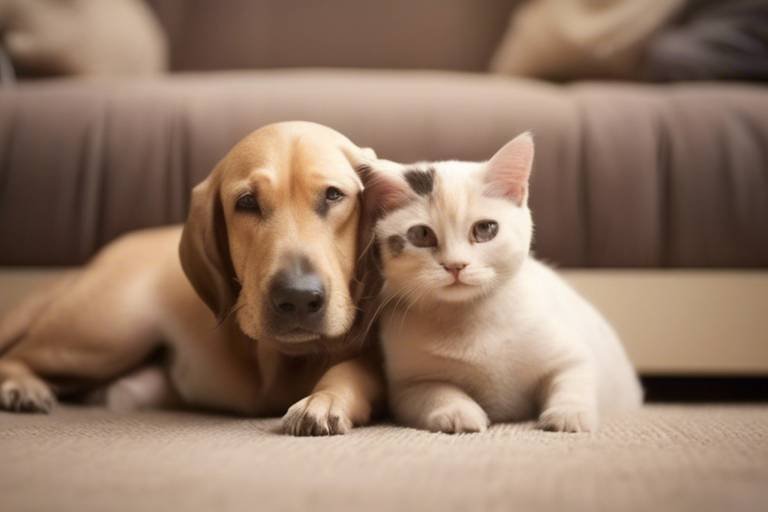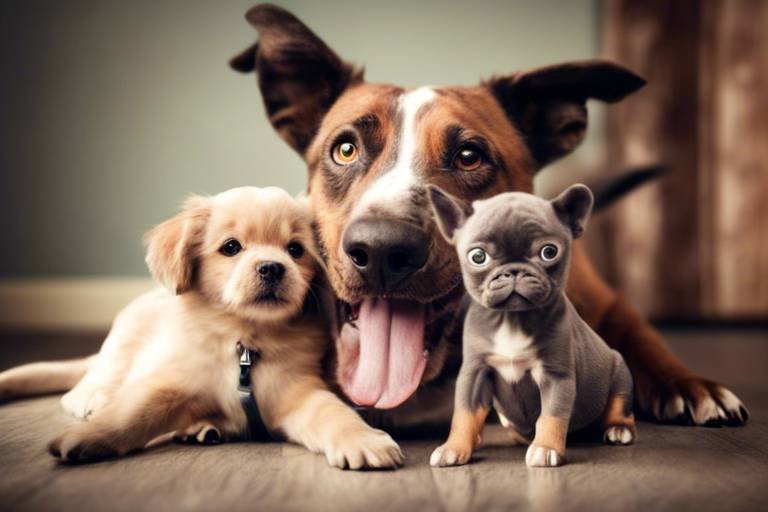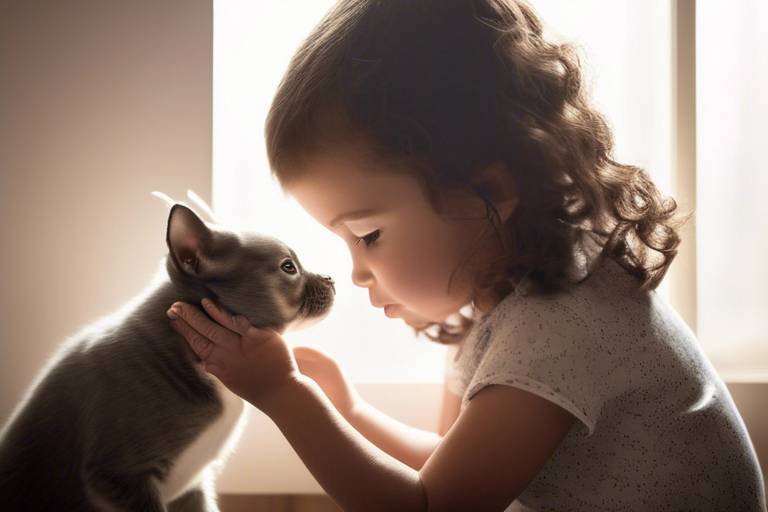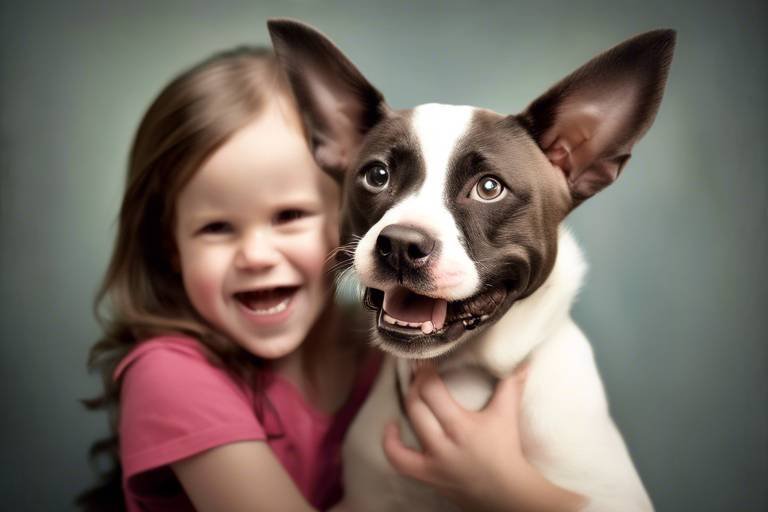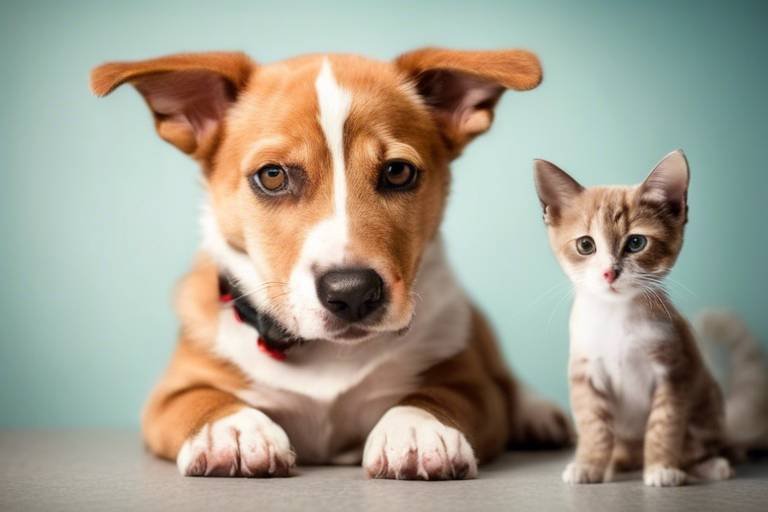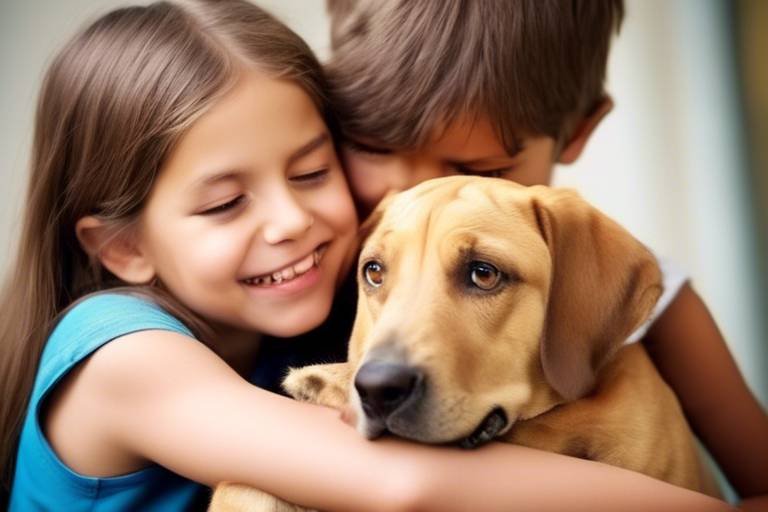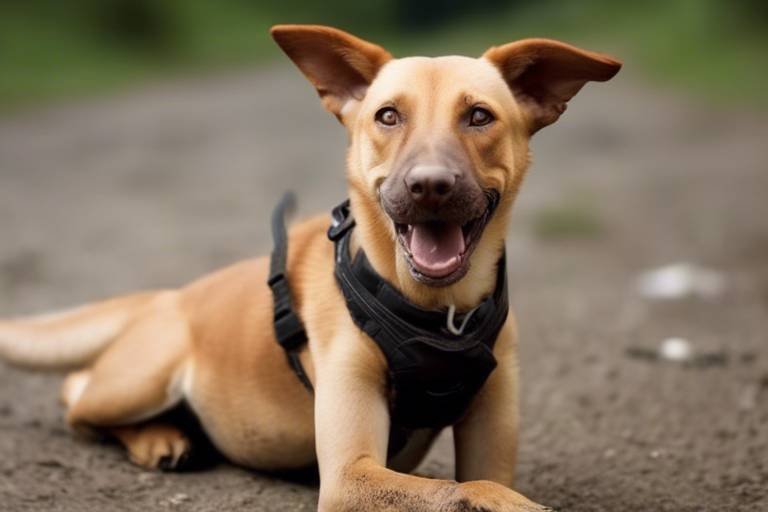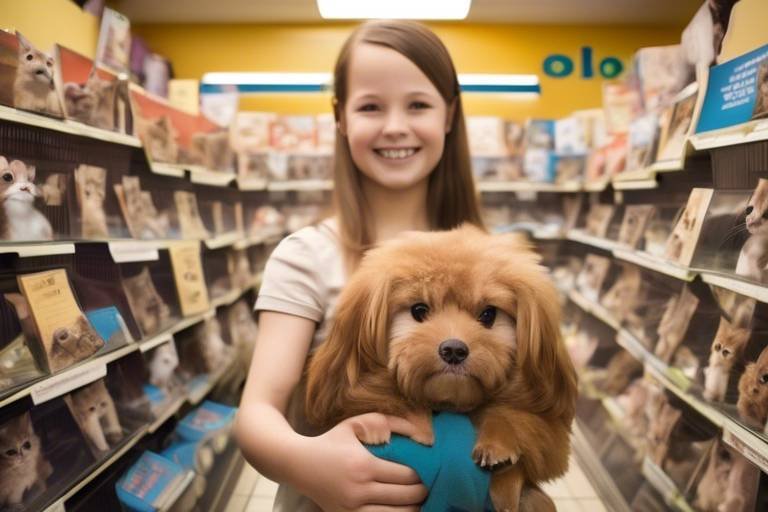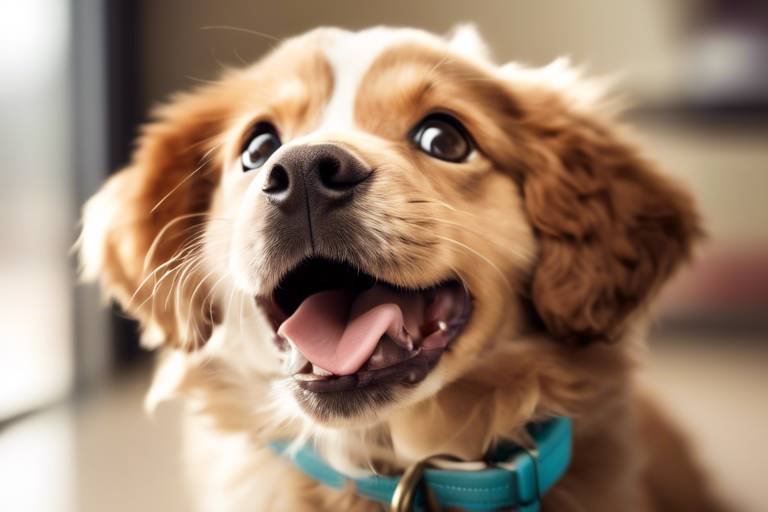Essential Supplies for New Pet Adopters
Bringing a new pet into your home is an exciting adventure, but it can also feel a bit overwhelming. You want to ensure that your new furry friend feels comfortable and secure in their new environment. To help with this transition, it’s crucial to gather the essential supplies that will make both your life and your pet's life easier. Think of it like setting up a cozy nest for a bird or a warm den for a dog—everything needs to be just right for the best experience. In this article, we’ll explore everything you need to create a happy and healthy home for your new pet.
First things first, let’s talk about the basics. Just like you wouldn’t move into a new place without furniture, your pet needs certain items to thrive. From food and water bowls to comfortable bedding and toys, every little detail counts. It’s not just about having the right supplies; it’s about creating an environment where your pet can feel safe, loved, and stimulated. So, what are the must-haves? Let’s dive in!
When considering the essentials, think about your pet's specific needs. For example, a puppy will require different items than a senior cat. It’s important to tailor your shopping list based on the type of pet you’re adopting. Below is a quick overview of some essential supplies you should consider:
| Supply Type | Description |
|---|---|
| Food and Water Bowls | Durable and easy to clean, these are essential for feeding and hydration. |
| Bedding | A cozy bed or blanket provides comfort for sleep and relaxation. |
| Toys | Interactive toys keep your pet engaged and help prevent boredom. |
| Grooming Supplies | Brushes, shampoos, and nail clippers to maintain hygiene and health. |
| Training Supplies | Leashes, collars, and training aids to help establish good behavior. |
As you gather these supplies, remember that this is not just about filling your cart at the pet store. It’s about investing in your pet’s happiness and well-being. Each item serves a purpose, whether it’s providing comfort, ensuring safety, or promoting health. Don’t forget to consider your pet’s personality—some pets may prefer plush toys, while others might enjoy something they can chew on. It’s all about finding what works best for your new companion.
In addition to the supplies mentioned, think about how you can make your home a welcoming space for your new pet. This could mean setting up a specific area for them to relax, keeping harmful substances out of reach, or even creating a little play zone. The goal is to make your home a sanctuary where your pet can thrive.
Lastly, let’s not overlook the importance of having a plan in place for ongoing care. This includes regular vet visits, vaccinations, and maintaining a healthy diet. Your pet’s health should always be a top priority, and having the right supplies will set the foundation for a long and happy life together.
- What are the most essential supplies for a new puppy? Puppies need food and water bowls, a comfortable bed, toys, grooming supplies, and training aids.
- How do I choose the right food for my pet? Consider your pet's age, breed, and any dietary restrictions when selecting food.
- What kind of toys are safe for my pet? Look for toys that are specifically designed for your pet's size and chewing habits to ensure safety.
- How can I pet-proof my home? Remove hazardous items, secure cords, and ensure that small objects are out of reach.

Choosing the Right Food
When it comes to your new furry friend, one of the most critical decisions you'll make is choosing the right food. This isn't just about filling their bowl; it's about providing optimal nutrition that supports their overall health and well-being. Think of it as laying the foundation for a happy, energetic life. Just like you wouldn't build a house on shaky ground, you shouldn't skimp on what goes into your pet's diet.
First off, consider your pet's age. Puppies and kittens have very different nutritional needs compared to adult or senior pets. For instance, young pets require food rich in protein and fat to support their rapid growth and development. On the other hand, older pets might need a diet lower in calories but higher in fiber to help with digestion and weight management. So, when you're at the store, look for food specifically formulated for your pet's age group.
Next, let’s talk about breed. Different breeds come with their unique health considerations and dietary needs. For example, large breeds like Great Danes may benefit from diets that support joint health, while smaller breeds may require food that caters to their higher metabolism. It's like choosing a tailored suit versus an off-the-rack option; one will fit better than the other!
Don't forget about any specific dietary needs your pet may have. Some pets might suffer from allergies or sensitivities that require a specialized diet. Ingredients like grain-free options or limited ingredient diets can be lifesavers for pets with food allergies. Always check the ingredient list and look for high-quality protein sources as the first ingredient. Avoid fillers like corn and soy that offer little nutritional value.
Moreover, it’s a good idea to consult with your veterinarian when selecting food. They can provide personalized recommendations based on your pet's health, lifestyle, and any specific requirements. Think of them as your pet’s personal nutritionist! They can help you navigate through the overwhelming choices available in pet stores and online.
| Age Group | Dietary Needs |
|---|---|
| Puppies/Kittens | High protein and fat for growth |
| Adults | Balanced diet for maintenance |
| Seniors | Lower calories, higher fiber |
Finally, remember that transitioning your pet to a new food should be done gradually. Sudden changes can upset their stomach, leading to discomfort and messes you definitely want to avoid. Mix the new food with the old food over a week or so, gradually increasing the new food's proportion until your pet is fully transitioned. Think of it as a gentle introduction rather than a surprise party; you want them to feel comfortable and happy with the change!
In summary, choosing the right food for your pet is a multifaceted decision that requires careful consideration of their age, breed, and individual dietary needs. By taking the time to research and consult with a veterinarian, you can ensure that your new companion receives the nutrition they need to thrive. After all, a well-fed pet is a happy pet!
- What should I look for in pet food? Always check for high-quality protein as the first ingredient and avoid fillers.
- Can I feed my pet human food? Some human foods are safe, but always check with your vet first!
- How do I transition my pet to new food? Gradually mix the new food with the old over a week to prevent stomach upset.

Comfortable Bedding Options
When it comes to ensuring your pet's happiness and comfort, choosing the right bedding is absolutely crucial. Just like we enjoy snuggling into a cozy bed after a long day, our furry friends deserve a soft and inviting spot to rest their heads. The right bedding not only provides comfort but also plays a significant role in their overall health. So, what should you consider when selecting the perfect bed for your pet? Let's dive into the world of comfortable bedding options!
First off, think about your pet's size and breed. A Great Dane will obviously need a different type of bed compared to a tiny Chihuahua. In fact, many pet stores offer a wide range of sizes to accommodate every breed. It's essential to choose a bed that allows your pet to stretch out comfortably without feeling cramped. Additionally, consider the bed's shape: some pets prefer a flat surface, while others like the security of a bolstered bed that provides a sense of enclosure.
Another important factor is the material of the bedding. Memory foam beds have gained popularity for their ability to provide excellent support, especially for older pets or those with joint issues. On the other hand, if your pet tends to get hot during the night, look for cooling gel-infused beds that help regulate body temperature. For those who love to chew or dig, durable and chew-resistant materials are a must. And let's not forget about the ease of cleaning! Waterproof or machine-washable covers can save you a lot of hassle in the long run.
Now, let's not overlook the importance of style! Your pet's bed can be a fun addition to your home decor. With so many colors, patterns, and designs available, you can easily find a bed that complements your living space. Some beds even come with removable covers that can be swapped out to match your seasonal decor. It's a win-win situation: your pet gets a comfy place to sleep, and your home looks fabulous!
To help you navigate the options, here's a quick comparison of some popular bedding types:
| Bedding Type | Best For | Key Features |
|---|---|---|
| Memory Foam | Older pets or those with joint issues | Supportive, pressure-relieving |
| Orthopedic | Pets recovering from surgery | Extra support, often thicker |
| Cooling Gel | Pets that overheat easily | Temperature regulation, breathable |
| Bolstered Bed | Pets that like to curl up | Security, soft sides for resting heads |
| Flat Bed | Pets that like to stretch out | Simple design, easy to clean |
Finally, remember that your pet's preferences matter! Take the time to observe where they like to sleep and what they seem to enjoy. Some pets prefer to nestle into a soft blanket, while others might love lounging on a plush bed. You might even consider introducing a few different options to see which one they gravitate toward. After all, a happy pet means a happy home!
What type of bed is best for a puppy?
Puppies generally benefit from beds that provide support and warmth. Look for a soft, washable bed that can withstand their playful nature.
How often should I replace my pet's bedding?
It's a good idea to replace your pet's bedding every 1-2 years, or sooner if it becomes damaged or excessively worn.
Can I use human bedding for my pet?
While you can use human bedding, it's best to choose materials that are pet-friendly and easy to clean, as pet hair and odors can accumulate quickly.

Essential Grooming Supplies
When you bring a new pet into your home, one of the most important aspects of their care is grooming. It's not just about keeping your furry friend looking fabulous; grooming is essential for their overall health and well-being. Just think of it as a spa day for your pet! Regular grooming helps to remove dirt, debris, and loose fur, which can prevent skin issues and allergies. But what exactly do you need to get started? Let’s dive into the essential grooming supplies that every new pet owner should consider.
First and foremost, brushes and combs are must-haves in your grooming toolkit. Depending on the type of fur your pet has, you'll need different tools. For instance, long-haired breeds often require a slicker brush to detangle and remove mats, while short-haired pets can benefit from a bristle brush to remove loose hair and distribute natural oils. A wide-tooth comb is also great for checking for any tangles or knots. It's like having the right tools for a job; the better equipped you are, the easier the process will be!
Next up, shampoo and conditioner specifically formulated for pets are essential. Human shampoos can be too harsh for a pet’s sensitive skin, so it’s important to choose products that are pH balanced and free from harmful chemicals. Look for natural ingredients that can soothe the skin and leave your pet smelling fresh. Bath time can be a fun bonding experience, so make sure you have everything ready to make it enjoyable for both of you.
Don’t forget about nail clippers or a nail grinder. Keeping your pet’s nails trimmed is crucial for their comfort and health. Overgrown nails can lead to painful walking and even joint issues. If you’re unsure about how to clip your pet’s nails, there are plenty of tutorials available online, or you can consult your veterinarian for tips. Just remember, patience is key! Start slow and reward your pet for their bravery.
Another essential tool is a toothbrush and toothpaste designed for pets. Dental health is often overlooked, yet it plays a vital role in your pet's overall health. Regular brushing can prevent the buildup of plaque and tartar, reducing the risk of gum disease and other health issues. Make it a routine, and your pet will thank you with a happy, healthy smile!
Finally, consider investing in a grooming table or a non-slip mat. This can make the grooming process much easier and more comfortable for both you and your pet. It keeps them secure and at a good height for you to work without straining your back. Plus, it gives your pet a designated space that they can learn to associate with grooming, helping to reduce anxiety.
In summary, having the right grooming supplies can transform the grooming experience from a chore into a delightful ritual. By keeping your pet well-groomed, you're not only helping them look their best but also ensuring they feel their best. Remember, grooming is an opportunity for bonding, so make it fun and rewarding for your furry friend!
Q: How often should I groom my pet?
A: The frequency of grooming depends on your pet's breed and coat type. Long-haired breeds may require grooming several times a week, while short-haired pets might only need it once a month.
Q: Can I use human shampoo on my pet?
A: No, it's best to use pet-specific shampoos as they are formulated to be gentle on their skin and avoid disrupting their natural pH balance.
Q: What if my pet doesn't like being groomed?
A: Start slowly and associate grooming with positive experiences. Use treats and praise to reward your pet, and gradually increase the duration of grooming sessions.

Safe Toys for Playtime
When it comes to our furry friends, playtime is not just a luxury; it’s a vital part of their daily routine. Engaging your pet with the right toys can lead to a happier, healthier life. But wait—before you rush to the store, let’s talk about safe toys. Just like us, pets can get hurt if they play with the wrong items. So, how do you choose the right toys that will keep your pets entertained while ensuring their safety?
First off, consider the material of the toys. Opt for non-toxic, durable materials that can withstand your pet’s chewing and playing habits. For instance, rubber toys are great for dogs as they are both tough and flexible. Cats, on the other hand, might enjoy feather wands or soft plush toys. It’s essential to pick toys that are appropriate for your pet’s size and play style. A toy that’s too small can pose a choking hazard, while one that’s too large might not be engaging enough.
Additionally, think about the type of play your pet enjoys. For active pups, consider toys that encourage fetching, like balls or frisbees. For more laid-back cats, interactive toys that mimic prey can stimulate their hunting instincts without putting them in danger. Variety is key! Having a mix of toys can keep your pet engaged and prevent boredom, which can lead to destructive behavior.
Here are some popular safe toy options for different pets:
- Dogs: Durable chew toys, rope toys, and interactive puzzle toys.
- Cats: Wand toys, laser pointers, and crinkle balls.
- Small pets: Chew sticks, tunnels, and soft plush toys.
Now, let’s not forget about the importance of regularly inspecting your pet's toys. Over time, wear and tear can create sharp edges or small parts that could be dangerous. Make it a habit to check toys for damage and replace them as needed. This simple step can significantly reduce the risk of injury during playtime.
In summary, choosing safe toys for your pet is crucial for their overall well-being. By considering the material, size, type of play, and regular maintenance of toys, you can create a fun and safe play environment for your furry companions. Remember, a happy pet means a happy home!
Q: How can I tell if a toy is safe for my pet?
A: Look for toys made from non-toxic materials, and ensure they are the appropriate size for your pet. Avoid toys with small parts that could be swallowed.
Q: How often should I replace my pet's toys?
A: Regularly inspect toys for wear and tear. Replace them as soon as you notice any damage to prevent potential injuries.
Q: Are there any toys I should avoid?
A: Yes! Avoid toys with small parts, sharp edges, or those made from harmful materials. Always prioritize your pet's safety over trends.

Training Essentials
When it comes to welcoming a new pet into your home, training is one of the most essential steps you can take to ensure a smooth transition for both you and your furry friend. Think of training as the foundation of a strong relationship; without it, misunderstandings and mischief can easily arise. So, what do you need to get started? Let’s dive into the must-have training essentials that will help you establish good behavior from the get-go.
First off, a sturdy leash and collar are non-negotiable. These items are not just for show; they are your primary tools for communication and control. A good leash allows you to guide your pet during walks, while a comfortable collar provides a secure place to attach identification tags. Remember, your pet will see the leash as a signal that it’s time for some fun, so choose one that feels right for both of you. If you have a larger breed, consider a leash that can handle their strength.
Next, let’s talk about training aids. These can range from clickers to treat pouches, and they play a crucial role in positive reinforcement. Using a clicker can help you mark the exact moment your pet performs the desired behavior, making it easier for them to understand what you want. On the other hand, a treat pouch allows you to have rewards handy during training sessions. It's like having a treasure chest of goodies that your pet can earn through good behavior!
Another essential item is a training mat. This can serve as a designated spot for your pet to relax or stay calm during training. It’s especially useful for teaching commands like “place” or “stay.” By associating the mat with positive experiences, your pet will learn to see it as a safe haven, which can significantly reduce anxiety during training sessions.
Now, let’s not forget about training books or courses. Investing in a good training resource can provide you with valuable insights and techniques to enhance your training experience. Whether you prefer reading or watching videos, having a structured approach can make all the difference. You’ll find that many resources also cover common behavioral issues, which can be incredibly helpful.
Lastly, don’t overlook the importance of patience and consistency. These are perhaps the most critical elements of training. Just like learning a new skill, your pet will need time to grasp commands and behaviors. Celebrate small victories and be prepared for setbacks. Consistency in your commands and routines will help your pet understand what is expected of them. Remember, training is a journey, not a race!
In summary, equipping yourself with the right training essentials will pave the way for a harmonious household. From collars and leashes to training aids and resources, each item plays a vital role in shaping your pet's behavior. So, gear up and get ready to embark on this exciting adventure together!
Q: How long should I train my pet each day?
A: Short, frequent sessions of 5-10 minutes are often more effective than longer sessions. Aim for 2-3 sessions a day to keep your pet engaged without overwhelming them.
Q: What if my pet doesn’t respond to training?
A: It’s important to remain patient. Every pet learns at their own pace. If you’re struggling, consider consulting a professional trainer for additional guidance.
Q: Can I train my pet without treats?
A: Yes! While treats are a popular method of positive reinforcement, you can also use praise, toys, or playtime as rewards. Find what motivates your pet the most!
Q: Is it too late to train an older pet?
A: Absolutely not! Older pets can learn new behaviors and commands, though it may take a bit more time. Be patient and consistent, and celebrate their progress.

Health and Wellness Products
When it comes to your pet's well-being, are not just optional; they are essential. Just like we humans need our vitamins and occasional check-ups, our furry friends require a similar level of care. Imagine a world where your pet is not only happy but also thriving in health—sounds amazing, right? Well, achieving that is easier than you think!
First and foremost, let’s talk about nutritional supplements. Depending on your pet's age, breed, and specific health needs, they may require additional vitamins and minerals to keep their body functioning optimally. For instance, senior pets often benefit from joint supplements, while active young pets might need extra energy-boosting nutrients. Always consult with your veterinarian to determine the best options for your pet.
Next up is flea and tick prevention. These pesky parasites can cause significant discomfort and health issues for your pet. Regularly administering prevention treatments can save you from the headache of dealing with infestations. There are various options available, ranging from topical treatments to oral medications. It's crucial to choose a product that is safe and effective for your pet's specific needs.
Another vital component of your pet's health routine is having a first aid kit. You never know when an accident might happen, so being prepared is key. A well-stocked first aid kit should include:
- Adhesive bandages
- Antiseptic wipes
- Gauze pads
- Medical tape
- Hydrogen peroxide (for cleaning wounds)
- Emergency contact numbers (vet, poison control)
Having these items on hand can make a world of difference in an emergency situation.
Moreover, don't overlook the importance of regular check-ups with your veterinarian. Just like we schedule our annual health screenings, our pets need the same attention. Routine vet visits can help catch potential issues before they become serious problems. They can also provide you with tailored advice on the best health products for your pet.
Lastly, let’s not forget about the significance of a pet insurance plan. While it may seem like an extra expense, having insurance can save you a significant amount of money in case of unexpected health issues. It's like having a safety net that ensures your pet gets the best care possible without breaking the bank.
In summary, investing in health and wellness products for your pet is a crucial step in ensuring they live a long, happy, and healthy life. By providing the right supplements, preventive care, and regular check-ups, you can create a solid foundation for your pet's well-being.
1. What are the essential health products I should have for my pet?
Every pet owner should have nutritional supplements, flea and tick prevention, a first aid kit, and a plan for regular vet visits. These products help ensure your pet stays healthy and happy.
2. How often should I take my pet to the vet?
Generally, it's recommended to take your pet for a check-up at least once a year. However, senior pets or those with specific health concerns may need more frequent visits.
3. Are there any home remedies for common pet ailments?
While some home remedies can be effective, it's always best to consult with your veterinarian before trying anything new. They can provide guidance on safe and appropriate treatments for your pet.

Travel Gear for Outings
When it comes to taking your furry friend on adventures, having the right travel gear is essential. Just like we wouldn't travel without our essentials, our pets need their own set of supplies to ensure a safe and enjoyable outing. Imagine planning a day at the park or a road trip without the necessary gear—chaos would surely ensue! So, let’s dive into the must-have items that will keep your pet comfortable and secure during your travels.
First and foremost, a reliable pet carrier is a game-changer. Whether you're heading to the vet, a friend’s house, or on a longer journey, a sturdy carrier provides a safe space for your pet. Look for one that is well-ventilated and large enough for your pet to stand up, turn around, and lie down comfortably. If you're traveling by car, consider getting a carrier that can be securely fastened with a seatbelt to prevent any sudden movements during the drive.
Next up is a pet safety harness. Just like we buckle up for safety, our pets deserve the same protection. A good harness will keep your pet secure in the car and prevent them from wandering around, which can be a major distraction while driving. Additionally, if you plan on taking your pet out for a stroll during your outing, a harness can offer better control than a collar, especially for those excitable pups who love to pull!
Don’t forget about hydration! Bringing along a portable water bowl is crucial, especially on warm days or during long drives. There are many collapsible options available that are easy to pack and can be filled up whenever your pet needs a drink. Keeping your pet hydrated is vital to their health, just like it is for us. Pair this with some travel-friendly dog food or treats to keep their energy up while on the go.
Another important item to consider is a pet first aid kit. Accidents can happen, and being prepared can make all the difference. A basic kit should include items like bandages, antiseptic wipes, and any medications your pet may need. Having these supplies on hand ensures that you can address minor injuries or issues promptly, giving you peace of mind during your adventures.
Lastly, consider a pet ID tag or microchip. While this isn't gear in the traditional sense, ensuring your pet has proper identification is crucial for their safety. If your pet were to get lost during an outing, having an ID tag with your contact information or a microchip can help reunite you quickly. It’s a simple step that can prevent a heart-wrenching situation.
In summary, preparing for outings with your pet involves more than just packing a few snacks. By investing in quality travel gear such as a pet carrier, safety harness, portable water bowl, first aid kit, and ensuring proper identification, you can create a safe and enjoyable experience for both you and your furry companion. So, before you hit the road, make sure you have all the essentials ready to go!
1. What should I look for in a pet carrier?
When choosing a pet carrier, ensure it is well-ventilated, spacious enough for your pet to move around, and secure enough to keep them safe during travel.
2. Is a harness necessary for my pet?
Yes! A harness provides better control and safety for your pet while traveling, especially in a car or when exploring new environments.
3. How can I keep my pet hydrated during outings?
A portable water bowl is ideal for keeping your pet hydrated on the go. Make sure to offer them water regularly, especially on warm days.
4. What should I include in a pet first aid kit?
Your pet first aid kit should include bandages, antiseptic wipes, tweezers, and any specific medications your pet may need. It's always better to be prepared!
5. How can I ensure my pet is identified if they get lost?
Make sure your pet has an ID tag with your contact information and consider microchipping them for added security. This can help reunite you quickly if they wander off.

Identification and Safety Items
When you bring a new pet into your home, one of the most critical aspects to consider is their identification and safety. Imagine the heart-stopping moment when your furry friend slips out the door or escapes from the yard. The right identification can be the difference between a joyful reunion and a long, anxious search. Thus, investing in proper safety items is not just a precaution; it's a necessity.
First and foremost, collars with ID tags are essential. A collar should fit snugly but not too tight—think of it as a comfortable hug for your pet. The ID tag should include your pet's name, your phone number, and any other relevant information. This way, if they wander off, a kind stranger can help bring them back home. It's also wise to consider a breakaway collar, which is designed to release if it gets caught on something, preventing choking hazards.
In addition to collars, microchipping is a highly recommended safety measure. This tiny chip, implanted just under your pet's skin, contains a unique identification number linked to your contact information. If your pet goes missing and is found by a vet or shelter, they can scan the chip and contact you. It's a simple, painless procedure that provides peace of mind for pet owners. According to the American Humane Association, microchipped pets are more than twice as likely to be reunited with their families than those without chips.
Moreover, consider investing in a GPS tracker. These devices attach to your pet's collar and allow you to track their location in real-time using your smartphone. This is especially useful for adventurous pets that love to explore. Knowing where they are at all times can alleviate your stress and keep your pet safe.
It's also important to think about the environment your pet will be living in. Pet-proofing your home is crucial for their safety. Here are a few tips to consider:
- Secure loose wires and cords to prevent chewing.
- Keep hazardous substances, like cleaning supplies and medications, out of reach.
- Install baby gates to restrict access to certain areas of your home.
Lastly, don't forget about emergency preparedness. Having a pet emergency kit can be a lifesaver in case of natural disasters or unexpected situations. This kit should include:
| Item | Purpose |
|---|---|
| First Aid Kit | To treat minor injuries |
| Food and Water | To sustain your pet during emergencies |
| Medications | For pets with ongoing health issues |
| Leash and Carrier | For safe transport |
In conclusion, ensuring your pet's safety and identification is a multifaceted approach that includes collars, microchips, GPS trackers, and a well-thought-out emergency plan. Taking these steps not only helps protect your pet but also gives you peace of mind. After all, a safe pet is a happy pet, and a happy pet means a happy owner!
Q: What should I include on my pet's ID tag?
A: Your pet's name, your phone number, and any relevant medical information are crucial. You can also include your address if space allows.
Q: Is microchipping painful for my pet?
A: No, microchipping is a quick and relatively painless procedure, similar to a vaccination.
Q: How can I ensure my pet's collar fits properly?
A: You should be able to fit two fingers between the collar and your pet's neck. If it's too tight or too loose, adjust accordingly.
Q: What should I do if my pet goes missing?
A: Immediately search your neighborhood, notify local shelters, and utilize social media to spread the word. If your pet is microchipped, inform the chip company as well.

Creating a Pet-Friendly Home
When you bring a new pet into your life, it's like opening a new chapter filled with joy, laughter, and, yes, a bit of chaos. But before you dive into this exciting adventure, you need to ensure your home is ready for your furry (or scaly) friend. Creating a pet-friendly home isn't just about making it comfortable for your pet; it's also about keeping them safe and happy. So, how do you transform your living space into a haven for your new companion? Let’s explore some essential tips.
First and foremost, consider the layout of your home. Pets, especially curious ones, love to explore. This means you should remove any hazardous items that could pose a threat. Think about it: your pet is like a toddler with a penchant for mischief! Items such as cleaning supplies, sharp objects, and electrical cords should be securely stored away. You can use childproof locks on cabinets or simply place these items on high shelves. This way, you can keep your pet safe while maintaining your home’s functionality.
Next, let’s talk about the floors. If you have hardwood or tile floors, consider adding some non-slip rugs to prevent your pet from slipping and sliding around. Not only do these rugs provide traction, but they also create cozy spots for your pet to lounge. If you’re worried about accidents, look for washable options. After all, accidents happen, and it’s better to be prepared!
Now, let’s not forget about the furniture. Pets love to jump on couches and beds, and while it’s adorable, it can lead to wear and tear. To protect your beloved furniture, consider using pet-friendly fabrics or throws that can easily be washed. Additionally, providing your pet with their own cozy spot, like a pet bed or a designated blanket, can help keep them off the furniture while giving them a sense of belonging.
Another crucial aspect of creating a pet-friendly home is ensuring that your space is mentally stimulating. Pets, especially dogs, need engagement to prevent boredom. Incorporate elements like scratching posts for cats or interactive toys for dogs. You might even consider setting up a small play area where your pet can safely explore and play. This not only keeps them entertained but also helps in establishing a routine, which pets thrive on.
Lastly, let’s touch on the outdoor space. If you have a yard, make sure it’s securely fenced to prevent any escape attempts. Regularly check for any gaps or holes that your pet could exploit. If you don’t have a yard, frequent trips to a nearby park can provide your pet with the exercise they need. Just remember to bring along their favorite toys and plenty of water!
In summary, creating a pet-friendly home involves a mix of safety, comfort, and stimulation. By taking the time to prepare your living space, you not only enhance your pet's quality of life but also set the stage for a harmonious household. Remember, your home is your pet's sanctuary, so make it a place where they can thrive!
- What should I do if my pet chews on furniture? Consider providing chew toys and redirecting their attention when they start chewing on furniture.
- How can I make my home safe for a new puppy? Remove any choking hazards, secure electrical cords, and use baby gates to restrict access to certain areas.
- Is it necessary to have a designated pet area? Yes! A designated area helps your pet feel secure and provides them with a space to relax.
Frequently Asked Questions
-
What type of food should I choose for my new pet?
Choosing the right food for your pet is crucial! Consider their age, breed, and specific dietary needs. For example, puppies require different nutrients than adult dogs. It's always a good idea to consult your veterinarian for personalized recommendations.
-
How can I create a comfortable sleeping area for my pet?
Creating a cozy sleeping area is essential for your pet's well-being. Look for bedding options that suit their size and sleeping habits. Soft, washable materials are often the best choice, and don’t forget to place the bed in a quiet, safe spot where they can relax.
-
What grooming supplies do I need for my pet?
The grooming supplies you'll need depend on the type of pet you have. Basic tools include brushes, nail clippers, and grooming wipes. Regular grooming not only keeps your pet looking good but also helps maintain their health!
-
Are there specific toys I should avoid for my pet?
Yes! Always choose toys that are safe and appropriate for your pet's size and chewing habits. Avoid toys with small parts that could be swallowed and steer clear of anything that’s too hard, which might damage their teeth.
-
What are the essentials for training my new pet?
Training your pet is vital for a happy home! Essential supplies include a sturdy leash, collar, and training treats. Consistency is key, so make sure to use positive reinforcement to encourage good behavior.
-
What health products should I have on hand for my pet?
To keep your pet healthy, consider having vitamins, flea prevention treatments, and a first aid kit readily available. Regular check-ups with your vet will also help ensure your furry friend stays in tip-top shape!
-
What travel gear do I need for my pet?
When traveling with your pet, safety is paramount! Essential travel gear includes a comfortable carrier, a safety harness, and possibly a pet seatbelt. This ensures your pet is secure and comfortable during your adventures together!
-
How can I ensure my pet is properly identified?
Proper identification is crucial for your pet's safety. Make sure they wear a collar with an ID tag that includes your contact information. Additionally, consider microchipping your pet as a permanent identification method in case they get lost.
-
What steps can I take to pet-proof my home?
Pet-proofing your home is essential for keeping your furry friend safe! Remove any hazardous items, secure loose wires, and ensure that toxic plants or substances are out of reach. Creating a secure environment allows your pet to explore safely!


